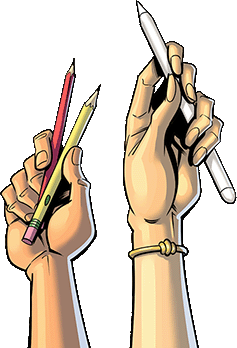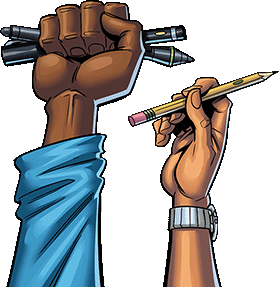How to Make a Comic Book for Kids?
March 23, 2023
Knowing how to make a comic book for kids can help you connect with the children in your life if you are a parent, teacher, or author. Comic books have been a beloved form of entertainment for people of all ages for decades. They are great for kids because they combine engaging visuals and exciting storytelling.
Comics can help young readers develop their imaginations, encourage creativity and self-expression, and foster a love for reading. Understanding how to make a comic book for kids, from initial planning and character development to the final stages of printing and distribution, is essential for completing your project.
Before starting the creative process of making your comic book, it’s essential to have a solid plan in place. This plan should include the story or concept you want to convey, the characters who will bring it to life, and the visual elements that will make it stand out. Take the following steps when planning your comic book:
Choosing a Story or Concept
A great comic book starts with a great story or concept. Take some time to brainstorm and come up with ideas that will resonate with your target audience. Consider your audience’s age, interests, and reading level, and try to develop a unique twist or perspective that will set your story apart from other comics.
For example, if you’re creating a horror comic book, think about elements like suspense, gore, and psychological horror to create a chilling and unforgettable experience for your readers. Consider your target readers’ age and comprehension skills to ensure your story is appropriate and engaging for their level.
Also, consider what kind of message you want to convey in your comic book. Do you want to inspire, entertain, or educate your readers? Once you have a clear idea of the message or theme you want to convey, you can start fleshing out your story.
Developing Characters
The characters in your comic book are what will connect with your readers and make it memorable. Characters should be well-developed, relatable, and engaging. Start by considering each character’s personality traits, quirks, and backstories.
Writing detailed character bios outlining each character’s likes, dislikes, motivations, and goals can be helpful. This will help you create more realistic, nuanced characters that readers will identify with and root for.
Writing a Script
With your story and characters in place, it's time to write the script. The script will serve as a blueprint for your comic book, outlining each panel’s dialog, action, and pacing. Keep your script concise and focused while allowing room for visual storytelling.
When writing a script, focus on creating exciting and dynamic dialog. Avoid long, exposition-heavy speeches and instead opt for snappy, engaging conversations that will keep your readers engaged. Be sure to include clear instructions for your artist regarding how the action should be depicted.
Sketching Out the Storyboard
Once you have the script, begin sketching out the storyboard. The storyboard is a visual representation of the comic book, showing each panel and how each flows together to tell the story.
Start by sketching out rough drafts of each panel, paying close attention to the composition and pacing of the story. This will help you identify potential issues before moving on to the final artwork. Consider visual storytelling elements, such as panel borders and page layouts.
Creating comic books online can also be a helpful tool for storyboarding. Various software and digital platforms are available to help you create a digital storyboard. These tools are handy for collaborative projects where multiple artists and writers work remotely.
With the help of digital tools like Storyboard That, you can easily share and make changes to the storyboard in real-time, making the process more efficient and streamlined.
Remember, your storyboard doesn’t have to be perfect at this stage. It’s more important to understand the story’s overall flow and identify any potential issues that must be addressed before moving on to the final artwork.
Comic Style and Layout
When creating a comic book for kids, the style and layout are crucial elements that can elevate a child’s reading experience. You’ll want to choose a style that appeals to kids, with an easily accessible format, layout, and panels and frames that add to the story.
Choosing a Style That Appeals to Kids
To ensure your comic book appeals to your target audience, consider their age group, interests, and reading level. For example, younger children may prefer bright and colorful visuals, while older kids may prefer a more intricate and detailed style.
Deciding on the Format and Layout
The format and layout of your comic book also play a significant role in its appeal. Consider the number of panels per page, the placement of dialog, and the story’s overall flow. Remember that kids have shorter attention spans, about two to three minutes per year of age, so make sure your panels are easy to follow and the story moves at the right pace for your target age group.
Creating Comic Book Characters
Creating unique and memorable characters is essential to crafting a compelling comic book for kids. The characters you develop can inspire and teach young readers, so create personas they can relate to.
How to Create a Unique and Memorable Character
Start by brainstorming different character ideas that fit the story or concept you have in mind. Consider their appearance, personality, backstory, and role in the story. Their journey will drive the story, so it’s necessary to give them a strong motivation that sets them apart from other characters.
For instance, your character may experience a traumatic event, such as the death of a parent or a move to a new home, which motivates their actions throughout the story. This will give your character a unique perspective and add depth to their personality, making them stand out in the minds of your young readers.
Designing Costumes and Appearance
Designing costumes and appearance is another crucial element to consider. The character’s appearance should reflect their personality, interests, and role in the story. Ensure their design is visually appealing and unique to help them stand out from other characters.
For example, the character of Wonder Woman uses an iconic costume with red, blue, and gold colors, along with her signature tiara, lasso, and bracelets. Her costume design reflects her strength, agility, and warrior background. It is also visually striking and unique, making her instantly recognizable to readers.
Giving Your Characters Quirks and Personalities
Consider adding quirks and personalities to your characters to make them more relatable and likable to your audience. Think about what makes your character special or unique, and use these traits to create memorable and engaging personalities. This will help readers connect with your characters and become more invested in the story.
Drawing and Inking Your Comic
Once you have your characters and storyboard finalized, it’s time to give life to your comic book. To achieve that, you must pay close attention to the drawing and inking techniques. For the best results, do the following:
Creating the Cover Page
The cover page is an essential element of your comic book, as it visually represents your story and can attract potential readers. Your cover should be visually striking and convey the overall tone of your comic.
Consider using an eye-catching picture, incorporating your main character, or using a title that stands out. The title should be easily readable from a distance, and the cover should give an idea of the story.
Inking Techniques
Inking is the process of outlining and defining your sketches with ink. The main goal is to create clarity and add depth and contrast to your artwork. There are various inking techniques, including brush, pen, and marker. You can experiment with different techniques to find what works best for your art style.
Start with a thin pen or brush and use thicker lines to add depth to your sketches. Shading is also essential to creating depth, and you can use techniques like cross hatching, stippling, or contour hatching to achieve different effects.
Coloring Your Artwork
Coloring is the process of adding color to your comic, and it is an excellent way to enhance the visual appeal of your artwork. Digital coloring using software like Photoshop or Procreate are popular methods, providing more control over the color and are easily editable.
You can also use traditional media like markers, pencils, or paints. When choosing a color scheme, consider the mood and tone of your story, and use color to differentiate between different scenes or characters.
Shadows and highlights can create contrast and add depth to your artwork, so experiment with different shading techniques to achieve the desired effect.

Lettering Your Comic
Lettering is a critical aspect of how to make a comic book for kids, as it conveys the words, dialog, narration, and sound effects that drive the story forward. When choosing a typeface and font size, readability is critical, especially for young readers.
Avoid overly decorative fonts that may be difficult to read, and opt for clear, simple lettering that complements your artwork. Balancing lettering with artwork is also essential, as overcrowded pages can be overwhelming and distracting.
Use speech bubbles and thought bubbles to indicate who is speaking or thinking, and create sound effects with onomatopoeia and unique lettering styles to add impact to your story.
Printing and Publishing Your Comic Book
Once you’ve created and finalized your comic book, it’s time to share it with the world. Comix Well Spring offers a variety of services to help you print, publish, and promote your comic book:
Printing Options and Costs
With Comix Well Spring, you can choose from several printing options, including saddle stitch binding for shorter comics or square bound for novel-length projects. You can choose from multiple sizes, such as the standard 6.625 x 10.25” or custom sizing. You can also print small runs of 25 to larger orders of over 5,000. Other customizations you can select for your comic book include:
- Cover paper (80#, 100#, or 12PT Holo-Chrome)
- Lamination
- Foil cover
- Interior paper (60#, 70#, 80#) coated or uncoated
- Full color or black and white interior
We also offer competitive pricing and discounts of between 5% and 32% for bulk orders.
Choosing a Distribution Strategy
Choosing the right distribution strategy is essential to getting your comic book into the hands of readers. Comix Well Spring offers an online comic marketplace where you can sell your comics directly to customers.
To get started, you’ll need to stock your inventory at our warehouse by placing an order for a minimum of 25 prints and choosing the “Store at CWS warehouse” shipping method. Once your inventory is ready, you can sign up as a vendor, enter your print order number, and choose your subscription pack.
From there, you can build your store profile, upload unlimited books, and set your prices. You can create discount coupons and monitor your sales and store visitors to drive traffic to your store.
Showcasing Your Comic Book in the Market
Comix Well Spring also offers additional printing services to help you promote your comic books, such as banners and business cards for trade shows or signings.
We can also print stickers, bookmarks, and other promotional materials like vinyl banners to help you get the word out about your comic book. You can increase visibility and reach a wider audience by showcasing your comic book in the market.
Inspire the Next Generation of Comic Book Readers
Creating a comic book for kids is a fun and rewarding experience, and the tips and techniques above can help you bring your ideas to life. Whether you’re creating a comic book for your child, your students, or for workplace training, remember to stay true to your vision and have fun with the process.
When you’re ready to bring your kid’s comic book into the world, let Comix Well Spring help with all your printing needs. With our expertise, your comic book can look professional and polished, ready to inspire the next generation of comic book readers.
Contact us at (734) 927-0044 to start your comic book journey today and discover the endless possibilities of how to make a comic book for kids!


